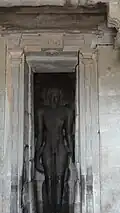Parshvanatha basadi, Shravanabelgola
Parshvanatha Basadi or Kamatha Parshvanatha Basadi is a Jain temple (basadi) located on Chandragiri Hill in Shravanabelagola, a town in Karnataka, India.
| Parshvanatha basadi, Shravanabelgola | |
|---|---|
ಪಾರ್ಶ್ವನಾಥ ಬಸದಿ | |
 Parshvanatha Basadi | |
| Religion | |
| Affiliation | Jainism |
| Deity | Parshvanatha |
| Festivals | Mahavir Jayanti |
| Location | |
| Location | Shravana Belgola, Hassan, Karnataka |
| Geographic coordinates | 12°51′18″N 76°29′06″E |
| Architecture | |
| Style | Dravidian architecture |
| Date established | 11th—12th century |
History
The Parshvanatha Basadi was built in the 11th–12th century CE[1] according to an inscription found on a temple pillar.[2] The manastambha pillar in front of the temple was erected by Puttayya during the reign of Chikka Devaraja (1645–1704 CE) of the Mysore Kingdom.[3]
The temple
The loft temple plan consists of a garbhagraha (inner sanctum), a shallow sukanasa (entrance ornament), a large pillared mandapa (pavilion), and a cornered porch. The temple stands on a high plinth of five moldings.[4] The temple's mulnayak, the idol of Parshva, is an 18 feet (5.5 m) monolithic idol standing over a lotus pedestal in the kayotsarga posture and a hood of seven-headed serpents overhead.[5] The idol has been noted as a fine example of craftsmanship with detailed carving of the hood and a sculptured lotus pedestal.[6] The manastambha is a 65.5 feet (20.0 m) tall pillar.[2] The pillar has a square base and is adorned with Jain images. The top of the pillar depicts a chaturmukha (four-faced) idol of Padmavati, four-armed Yaksha, Kushmandini and Brahma riding on a horse.[5][3] Parshvanatha basadi is considered the most important in the Jain temple complex of Chandragiri Hill for its architecture.[7]
This temple is one of the Archaeological Survey of India's Adarsh Smarak Monument along with other temples in the Shravanabelagola group of monuments.[8]
Photo gallery
 18 feet (5.5 m) Parshvanatha statue
18 feet (5.5 m) Parshvanatha statue Lathe-turned pillar
Lathe-turned pillar
References
Citations
- Knapp 2008, p. 496.
- Chugh 2016, p. 290.
- ASI.
- Chugh 2017, p. 312.
- Sangave 1981, p. 15.
- Chugh 2016, p. 289.
- Rao 2020, p. 4.
- "Adarsh Smarak Monument". Archaeological Survey of India. Archived from the original on 2 May 2021. Retrieved 19 July 2021.
Sources
- Chugh, Lalit (2016). Karnataka's Rich Heritage - Art and Architecture (From Prehistoric Times to the Hoysala Period ed.). Chennai: Notion Press. ISBN 978-93-5206-825-8.
- Chugh, Lalit (2017). Karnataka's Rich Heritage – Temple Sculptures & Dancing Apsaras: An Amalgam of Hindu Mythology, Natyasastra and Silpasastra. Chennai: Notion Press. ISBN 978-19-4713-736-3.
- Knapp, Stephen (2008). Seeing Spiritual India. iUniverse. ISBN 9780595614523.
- Sangave, Vilas Adinath (1981). The Sacred ʹSravaṇa-Beḷagoḷa: A Socio-religious Study. Murtidevī granthamālā. Vol. 8. Mumbai: Bhartiya Jnanpith. ISBN 9789326355599.
- ASI. "Parsvanatha Basti, Sravanabelagola". Archaeological Survey of India. Retrieved 19 July 2021.
- Rao, Nalini (15 June 2020). "New Perspectives on Jain Architecture and Sculpture at Shravanabelagola". Buddhist Studies Commons, Hindu Studies Commons, History of Religions of Eastern Origins Commons. 2 (3). Shawnee State University.
{{cite journal}}: Cite journal requires|journal=(help)
External links
 Media related to Parshvanatha Basti, Shravanabelagola at Wikimedia Commons
Media related to Parshvanatha Basti, Shravanabelagola at Wikimedia Commons